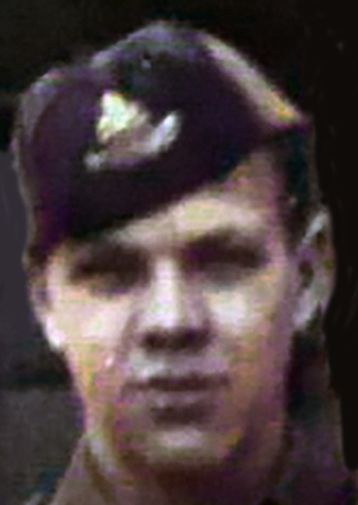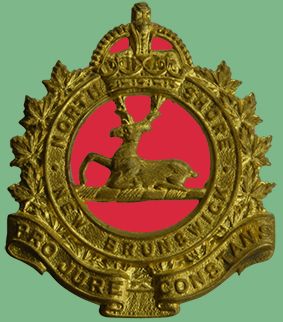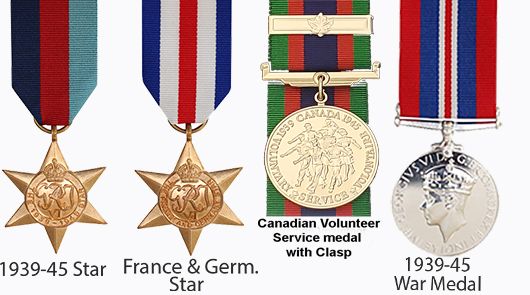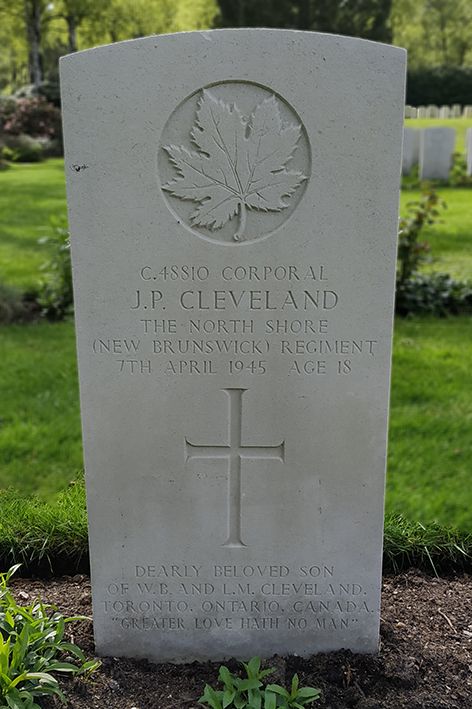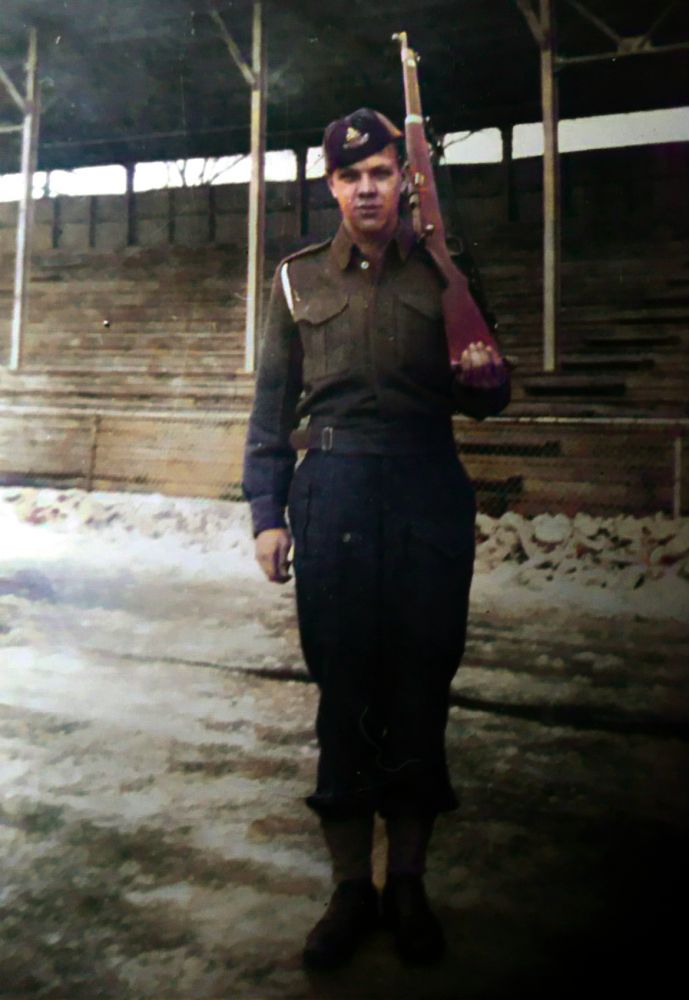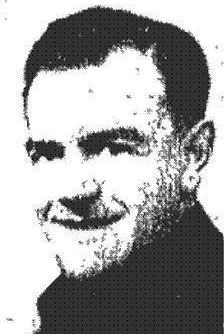corporal
Cleveland, John Patterson
Service nummer C/48810
Overleden 1945-04-07
Leeftijd 20
The North Shore (New Brunswick) Regiment
John Patterson Cleveland
werd geboren op 17 september 1926 in Toronto, ON, als de zoon van William Bennett Cleveland en Lillian Maude (geboren Patterson). Vader William werkte in de kledingindustrie als snijder. John was de jongste van drie kinderen. Broer William Jr. diende in WO II bij de marine en zus Marjorie bij de Royal Canadian Air Force vrouwendivisie. Het gezin woonde op 97 Linsmore Crescent in een rustige buurt aan de oostkant van Toronto en bezocht de Anglicaanse kerk. Op zestienjarige leeftijd verliet John de school en werkte hij twee jaar voor Sangamo Electric, dat een elektromotorbedrijf exploiteerde in Leaside. Wanneer hij niet aan het werk was hield John van schaatsen, hockey, honkbal, jagen en geschiedenis lezen.
Hij had een rijbewijs en hield van motoren. Uit gegevens blijkt dat John ook enige militaire ervaring had opgedaan met de zeekadetten.
In november 1941 schreef John zich in bij de Non-Permanent Active Militia (NPAM). Deze militie bestond uit vrijwillige soldaten die trainden op doordeweekse avonden, weekenden en op zomerkampen. Ze werden betaald en er kon een beroep op worden gedaan voor de locale verdedigings activiteiten. Een jaar later werd ontdekt dat John minderjarig was. De militaire gegevens tonen verschillende geboortedata en bevatten een aantekening dat hij was ontslagen uit de militie in december 1942 wegens minderjarig zijn. Een document ondertekend door zijn moeder vermeldt zijn geboortedatum op 17 september 1926.
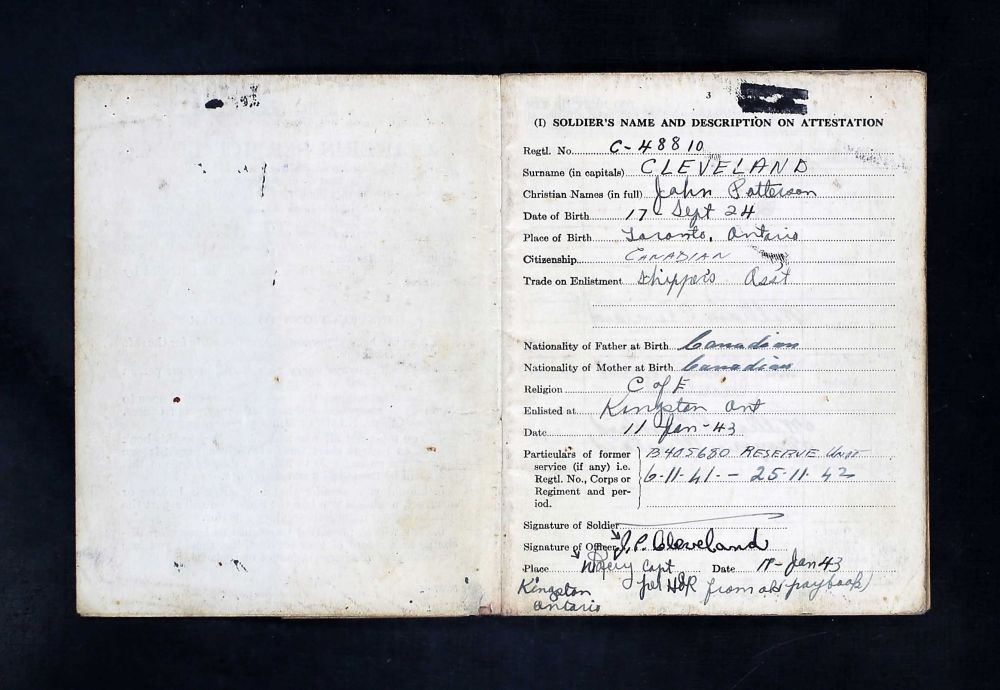
John Patterson Cleveland - Soldatenboekje -Soldiers Paybook (Bron: Canada, WWII Service Files of War Dead, 1939-1947)
John gaf niet op. Een maand later, in januari 1943, reisde hij naar Kingston, ON, en nam dienst om ingezet te worden waar hij maar nodig was. Nogmaals, zijn geboortedatum was niet correct vermeld, zijn aanvraag werd aanvaard, en hij was op zestienjarige leeftijd in het leger.
Zijn scores op de proeve van bekwaamheid gaven aan dat hij een bovengemiddeld vermogen had om een goed soldaat te zijn en hij werd geplaatst bij de Royal Canadian Artillery (RCA) met de rang van schutter. Basistraining werd voltooid in kamp nr. 32 in Peterborough, en daarna trainde hij met luchtafweereenheden, voornamelijk in de buurt van Halifax.
Uit gegevens blijkt dat John in februari 1944 werd overgeplaatst naar het Canadian Infantry Corps (CIC) en getraind heeft met de infanterie in Cornwall en Ipperwash, Ontario. In juli werd hij verscheept naar het Verenigde Koninkrijk en werd toegewezen aan de Canadian Infantry Reserve Unit (CIRU). Op 12 augustus werd John overgeplaatst over het kanaal naar Normandië, Frankrijk, en drie dagen later sloot hij aan bij het North Shore (NewBrunswijk) Regiment. Met het NSR ging hij noordwaarts en eind augustus werd door het regiment de Seine overgestoken. Vervolgens namen zij deel aan het bevrijden van de zeehavens aan de Franse.
In oktober vocht John in de meedogenloze en dodelijke Slag om de Schelde. De Canadezen kregen de opdracht om de noord- en zuidkust van de rivier de Schelde te ontruimen die langs de Nederlands/Belgische grens stroomt en in de Noordzee uitmond. Antwerpen, dat 80 kilometer landinwaarts ligt, was een belangrijke scheepvaarthaven, en de geallieerden hadden de haven nodig om bevoorrading te krijgen. De stad was in september door de Britten ingenomen, maar de toegang tot de rivier werd nog steeds over de volle 80 kilometer gecontroleerd door de Duitsers. Na een maand lang vechten in de regen, de kou, de modder en het overstroomde terrein gaf generaal Montgomery de Canadezen de bijnaam “de Water Rats”. Op 8 november was de monding van de Schelde geruimd en op 28 november arriveerden 18 schepen met 10.000 ton voorraden in Antwerpen. Dit was ten koste gegaan van 6.367 Canadese slachtoffers.
In januari 1945 werd John bevorderd tot de rang van korporaal.
Op 8 februari 1945 vielen de Canadezen Duitsland binnen en in de nacht van 24 op 25 maart trok de NS(NB)R de Rijn over en staken begin april de grens over naar Nederland om alle door Duitsland bezette gebieden te veroveren en de Nederlanders te bevrijden. De NS(NB)R en Le Régiment de la Chaudière kregen nu opdracht om de Nederlandse stad Zutphen op de oostelijke oever van de rivier de IJssel in te nemen. Zutphen is een vrij grote stad, en bevat naast de rivier de IJssel en de Berkel veel grachten die nog stammen uit de middeleeuwen. Deze waterwegen maakten onderdeel uit van de verdediging van de stad en vormden een natuurlijke verdedigingsbarrières omdat alle bruggen over de kanalen door de vijandelijke springcommando’s waren vernietigd.
Er waren hier veel jonge Duitse soldaten. Ze werden opgeleid in de nabijgelegen school voor parachutisten en sommigen waren nog maar veertien jaar oud. Ze werden in het nauw gedreven, vochten met wanhoop en waren uitstekende schutters met sniper- en machinegeweren.
De grond was te zacht voor tanks en dus ging de aanval zonder hun bescherming verder. Geallieerde artillerie vuurde 25-pond granaten af op de stad en de Duitsers reageerden met hun artillerie vanaf de westkant van de rivier de IJssel.
Op vrijdag 6 april rukten NS(NB)R en de Chaudières op vanuit het oosten op Zutphen. De Chaudières leidden de aanval naar het hart van de stad. North Shore B- en D Companies rukten op aan hun rechterflank. Compagnie A en C volgden op de linkerflank van de Chaudière. Een opgeblazen brug bij de Deventerweg (latere Canadezenbrug) in combinatie met hevig Duits verzet bracht al snel de voortgang van alle eenheden tot stilstand.
Op zaterdag 7 april wisten North Shore C Company (met Cpl Cleveland) en Support Company hun mannen en drie carriers met machinegeweren en vlammenwerpers over een verzonken brug te krijgen. Na een korte verkenningstocht over het terrein reden de carriers op volle snelheid de verdedigde straten van Zutphen in terwijl hun Browning-machinegeweren op bijna alles wat bewoog vuurden. Toen ze hun doelen bereikten, werden de vlammenwerpers ingezet en daarmee de belangrijkste verdedigingsposities geëlimineerd.
De sluipschutters waren echter nog steeds dodelijk. In het boek van Will Bird, The North Shore (NB) Regiment, verklaarde Majoor Oulton (de commandant van C Company) dat een vijandelijke sluipschutter Corporaal J.P. Cleveland had gedood, een eersteklas vechtende onderofficier die vele aanvallen had doorstaan. Cpl John Cleveland was achttien jaar oud.
The War Diary registreert dat om 13.00 uur. op 8 april was Zutphen tot aan de IJssel ontruimd.
Vijftien North Shore-mannen werden gedood in Zutphen (negen werden ofwel geboren in New Brunswick of woonden daar) Vader Hickey schreef: "de meeste waren geveld door Duitse sluipschutters." De volgende ochtend werd de mis opgedragen in de overblijfselen van het Zutphense schoolgebouw (School A – de Jan Lighthartschool). Hickey schreef: "Toen de mannen naar de Heilige Communie kwamen, kon ik in elk oorlogsmoe gezicht mijn eigen dierbaarste hoop lezen, de hoop dat het einde nabij was."
John Patterson Cleveland werd tijdelijk begraven bij het Elger in Almen en kreeg zijn definitieve rustplaats op 28 januari 1946 in de Canadese oorlogsbegraafplaats in Holten, graf I.G. 2.
Hij wordt jaarlijks herdacht bij het monument bij het Elger in de dorpsstraat in Almen.
Deze biografie werd geschreven met hulp van Bruce Morton uit Barrie, Ontario, Canada.

John Patterson Cleveland
was born September 17, 1926, in Toronto, ON, the son of William Bennett Cleveland and Lillian Maude (Patterson). William worked in the clothing business as a cutter. John was the youngest of three children with a brother William and a sister Marjorie. William Jr. served in the navy and Marjorie with the RCAF women’s division in WWII. The family lived at 97 Linsmore Crescent in a quiet neighbourhood in Toronto’s east end and attended the Anglican church. At age sixteen, John left school and worked for two years for Sangamo Electric that operated an electric motor business in Leaside. When not working, John liked skating, hockey, baseball, hunting, and reading history. He had a driver’s license and liked motorcycles. Records show that John had also gained some military experience with the sea cadets.
In November 1941, John enrolled with the Non-Permanent Active Militia (NPAM). This militia was composed of volunteer soldiers who trained on weeknights, weekends, and at summer camps. They were paid and could be called upon for home defense. A year later it was discovered that John was underage. The military records show several dates of birth and include a note that he was discharged from the militia in December 1942 for being underage. A document signed by his mother states his birthdate as September 17, 1926.

John Patterson Cleveland - Soldatenboekje -Soldiers Paybook (Bron: Canada, WWII Service Files of War Dead, 1939-1947)
John did not give up. A month later, in January 1943 he traveled to Kingston, ON, and enlisted for active duty wherever he was needed. Again, his birthdate was not correctly stated, his application was accepted, and he was in the army at sixteen years of age.
His aptitude test scores indicated that he had above-average ability, and he was placed with the Royal Canadian Artillery (RCA) with the rank of Gunner. Basic training was completed at Camp No.32 in Peterborough, and afterward, he trained with Anti-Aircraft units, primarily near Halifax.
Records show that in February 1944, John was transferred to the Canadian Infantry Corps (CIC). and trained with the Infantry at Cornwall and Ipperwash, ON. The following July he embarked for the United Kingdom and was assigned to the Canadian Infantry Reserve Unit (CIRU). On August 12 John was transferred across the channel to Normandy, France, and three days later was placed with the North Shore (New Brunswick) Regiment. Arriving when he did, Pte Cleveland would have advanced north with the regiment and crossed the River Seine at the end of August.
Historian C. P. Stacey wrote that on August 26, 1944, General Montgomery assigned the Canadians the task of capturing all ports and removing all German forces along the French coast of the English Channel. These ports were needed to accelerate the movement of men and supplies to the front lines. The Germans were also using the coast to fire shells and launch V1 rockets across the channel into England.
The NS(NB)R was ordered to capture the fortresses at Wimereux, La Trésorerie, Wimille, Sangatte, and Calais, that formed part of the German Atlantic Wall. These objectives were all achieved by September 26, but the cost was twenty-five fatal casualties.
In October John fought in the brutal and deadly Battle of The Scheldt. The Canadians were ordered to clear the north and south shores of the Scheldt River that flows along the Dutch/Belgium border and into the North Sea. Antwerp was a major shipping port, 50 miles inland, and the Allies needed it to get supplies to the front. The city had been captured by the British in September but the 50 miles of river access were still controlled by the Germans. Following a month-long fight in the rain, the cold, the mud, and the flooded terrain, Gen. Montgomery nicknamed the Canadians the Water Rats. On November 8, the Scheldt River estuary was cleared and on November 28, 18 ships with 10,000 tons of supplies arrived at Antwerp. The cost was 6,367 Canadian casualties. In January 1945, John was promoted to the rank of Corporal.
On February 8, 1945, the Canadians invaded Germany and on the night of March 24/25, the NS(NB)R crossed the Rhine River into the heart of Germany.
In early April the Canadians turned northwest and crossed the border back into the Netherlands to capture all German-held regions and liberate the Dutch. The NS(NB)R and Le Régiment de la Chaudière were now ordered to capture the Dutch town of Zutphen on the east bank of the Ijssel River. Zutphen is a fairly large town, and the river is partially diverted through a series of canals mainly on the south and the east sides of the city. These created natural defense barriers and all bridges over the canals had been destroyed.
There were many young German soldiers here. They were being trained at the nearby school for paratroopers and some were as young as fourteen. They were cornered, fighting with desperation, and were excellent shots as snipers and with machine guns.
The ground was too soft for tanks and so the attack proceeded without their protection. Allied artillery fired 25-pound shells into the town and the Germans responded with their artillery from the west side of the Ijssel River.
On Friday, April 6, NS(NB)R and the Chaudières advanced on Zutphen from the east. The Chaudières led the attack into the heart of the town. North Shore B and D Companies advanced on their right flank. A and C Companies followed on the Chaudière’s left flank. A blown bridge combined with intense German resistance soon brought the progress of all units to a halt.
On Saturday, April 7, North Shore C Company (with Cpl Cleveland) and Support Company were able to get their men and three carriers with machine guns and flamethrowers across a sunken bridge. After a short reconnaissance tour of the site, the carriers drove at full-speed into the defended streets of Zutphen while their Browning machine guns fired at almost anything that moved. Upon reaching their targets, they blasted full flame onto the enemy positions. The main defense positions were eliminated.
The snipers were still deadly, however. In Will Bird’s book, The North Shore (NB) Regiment, Maj Oulton (CO of C Company) stated that an enemy sniper killed Cpl J. P. Cleveland, a first-class fighting NCO who had come through many attacks. Cpl John Cleveland was eighteen years of age. The War Diary records that by 1 p.m. on April 8, Zutphen had been cleared right through to the Ijssel River.
Fifteen North Shore men were killed at Zutphen (Nine were either born in New Brunswick or lived there) Father Hickey wrote, “most had been picked off by German snipers.” The next morning, Mass was held in the remains of the Zutphen schoolhouse. Hickey wrote, “As the men came up to Holy Communion, in each war-weary face I could read my own fondest hope, the hope that the end was near.”
For his service to Canada Cpl John Patterson Cleveland was awarded the following medals; the 1939-45 Star, France & Germany Star, War Medal 1939-1945, and Canadian Volunteer Service Medal with Clasp. John Patterson Cleveland is buried in the Holten Canadian War Cemetery in the Netherlands, Plot I. G. 2.
This biography was written by Bruce Morton from Barrie, Ontario, Canada.
